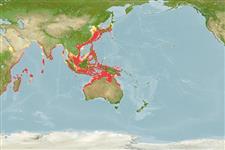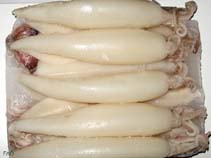Uroteuthis edulis (Hoyle, 1885)
Swordtip squid| Native range | All suitable habitat | Point map | Year 2050 |

|
| This map was computer-generated and has not yet been reviewed. |
| Uroteuthis edulis AquaMaps Data sources: GBIF OBIS |
Classification / Names Common names | Synonyms | CoL | ITIS | WoRMS
Cephalopoda | Myopsida | Loliginidae
Environment: milieu / climate zone / depth range / distribution range Ecology
Demersal; oceanodromous (Ref. 75927); depth range 30 - 170 m (Ref. 275). Tropical; 15°C - 28°C (Ref. 75930); 53°N - 27°S, 32°E - 150°E (Ref. 97142)
Distribution Countries | FAO areas | Ecosystems | Occurrences | Introductions
Indo-Pacific. Tropical to temperate.
Length at first maturity / Size / Weight / Age
Maturity: Lm 7.4 range ? - ? cm Max length : 50.0 cm ML male/unsexed; (Ref. 75927)
Also caught by jigs and set nets. 30cm in Hong Kong, common mantle length in commercial catches ranges between 15 and 25 cm (Ref. 3722). Found in the continental shelf; winters inshore, in shallow waters. Spawning period extends throughout the year, with peaks in spring, summer, and autumn. Spawning grounds were recorded from 30 to 100 m, on sandy bottom in coastal waters influenced by inflow of warm oceanic currents. Life span is about one year. Juveniles prefer crustaceans; adults primarily feed on fishes (Ref. 114973).
Life cycle and mating behavior Maturity | Reproduction | Spawning | Eggs | Fecundity | Larvae
Members of the class Cephalopoda are gonochoric. Male and female adults usually die shortly after spawning and brooding, respectively. Mating behavior: Males perform various displays to attract potential females for copulation. During copulation, male grasp the female and inserts the hectocotylus into the female's mantle cavity where fertilization usually occurs. Life cycle: Embryos hatch into planktonic stage and live for some time before they grow larger and take up a benthic existence as adults.
Main reference
References | Coordinator | Collaborators
Roper, C.F.E., M.J. Sweeney and C.E. Nauen. 1984. (Ref. 275)
IUCN Red List Status
(Ref. 130435: Version 2024-2)
Data deficient (DD) ; Date assessed: 01 July 2015
CITES status (Ref. 108899)
Not Evaluated
CMS (Ref. 116361)
Not Evaluated
Threat to humans
Human uses
Fisheries: commercial
| FishSource |
Tools
More information
Trophic Ecology
Ecology
Population dynamics
Growth
Max. ages / sizes
Length-weight rel.
Length-length rel.
Length-frequencies
Mass conversion
Recruitment
Abundance
Max. ages / sizes
Length-weight rel.
Length-length rel.
Length-frequencies
Mass conversion
Recruitment
Abundance
Life cycle
Distribution
Human Related
Aquaculture profiles
Stamps, coins, misc.
Stamps, coins, misc.
Outreach
Taxonomy
References
Internet sources
BHL | BOLD Systems | CISTI | DiscoverLife | FAO(Publication : search) | Fishipedia | GenBank (genome, nucleotide) | GloBI | Gomexsi | Google Books | Google Scholar | Google | PubMed | Tree of Life | Wikipedia (Go, Search) | Zoological Record
Estimates based on models
Preferred temperature
(Ref. 115969): 21.8 - 28.1, mean 26.6 (based on 297 cells).
Prior r = 1.06, 95% CL = 0.70 - 1.59, Based on 1 data-limited stock assessment.



